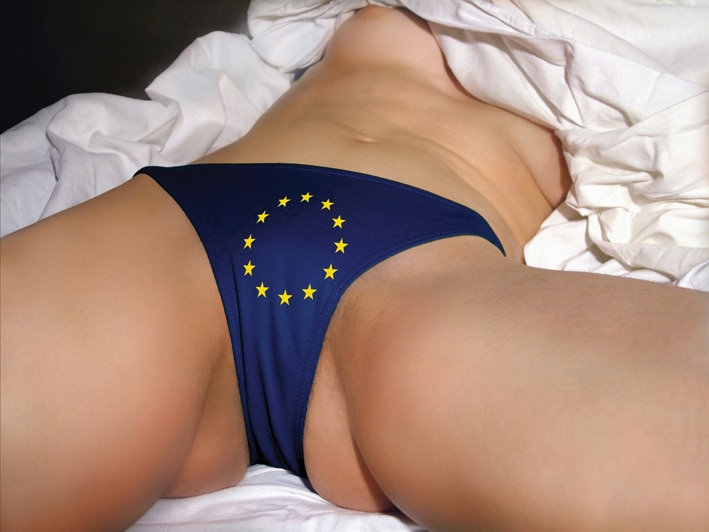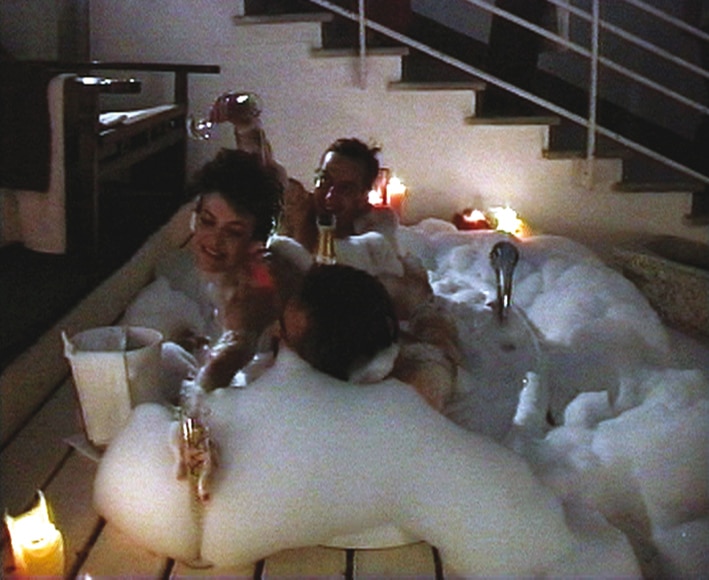Tanja Ostojić
Erotic meets the political in Tanja Ostojić’s work
Ever since Walter Benjamin recognised the relation between politics and aesthetics by blaming Fascism for introducing aesthetics into political life and Communism for politicizing art, the link between the artistic and the political has become an inevitable point of the discussion in troubled periods and regions. In addition the connection between beauty and the eroticism of destruction, violence and politics was established (by both Benjamin and Susan Sontag) in order to try to explain the excitement of images of violence and aggression. My question in this text in contrary is whether the works of Tanja Ostojić and the images of her body could be considered as entanglements of the erotic and the political and how this relationship can be disentangled without referring to excitement.
The political implications of a certain cultural space and its representational order are usually hidden and it is the role of the artist to reveal them. It was not an accident that Ostojić’s project Untitled/After Courbet, 2004 (photo, 46 X 55 cm), provoked a scandal in Austria and ultimately was censored. The work was presented in a form of a “rolling” billboard in the context of the group exhibition 25 Peaces (on Reflections about Austria in the Nazi-Era) curated by Walter Seidl & Ursula Maria Probst in Vienna and Salzburg, followed up by the project titled PEACE gerollt and the exhibition euroPart that hosted 400 rolled art billboards. Ostojić’s billboard showed her widely spread legs with the EU “logo”: blue knickers and a circle of yellow stars as a kind of target, obviously referring both to the European Union’s enlargement and to Gustave Courbet’s renowned painting. The porn-scandal campaign against the project was generated by the December 29 issue of the newspaper Kronen Zeitung, a right wing tabloid that itself publishes topless photographs with soft porn content.
However, according to the artist’s and curators’ views, the only pornography deployed in this case was the one of the hypocritical views of the local press and politicians and their fears to discuss openly the issues of Europe’s enlargement, immigration policy and integration. Even though the newspaper that started the campaign publishes pornography on everyday basis it attacked as “porn” the presentation of the work that did not show any explicit sexual part of the body but questioned the European policy and fear of inclusion/penetration of the “others.” The work but also the whole scandal proved that the relationship between European Union and the aspiring states is still treated as a sexual and not a love relationship and that it can easily be transformed into “coitus interruptus” when the fear of all-inclusiveness will win over the desire.
The artistic and the cultural strategies are means that can help reveal the implications in the imaginary realm or employing images as metaphors for the hidden political agendas. Once these hidden political tropes of our cultural space and the regimes of representation are unravelled in the realm of the imaginary, then we can expect that the relation between the erotic and politics becomes evident. This is the case in most of the projects by Tanja Ostojić.
With the project Looking for a Husband with an EU Passport already in 2000 she sparked controversy by exposing her body in the add announcing her quest for a husband who would meet the only criterion, to be the holder of a European passport. The first phase of the project consisting of a simple Internet advert with an image of the artist’s shaved body and the title developed by distribution of leaflets and posters in a shopping mall in Skopje, Macedonia (2001, public art project Capital and Gender), and through the website that enabled the correspondence between Ostojić and her ‘suitors.’ (http://www.cac.org.mk/capital/ projects/tanja/).
The project had gradually transferred from the realm of the ‘imaginary’ to the realm of the ‘real’ when the artist met and married one of the ‘virtual’ suitors in an artistic but administratively valid marriage. Unfortunately for the artist, a real marriage did not ensure the issue of a real passport. The final stage of this long-term art and life commitment started in the realm of a complex intertwining between the ’imaginary’, the ‘real’, and the ‘symbolic’: when the artist started to face the German state authorities in order to acquire the long-awaited Schengen visa and began going through the seemingly endless procedures for long-term residency, that did not have anything to do with the excitement of sex and eroticism.
At this point, the artist herself could not control any more the ‘rules of the game’ and after three years of ‘fictitious’ marriage, the couple split and filed for a ‘real’ divorce that ended the marriage without fulfilling the ultimate task exactly because the marriage was based on the urgency to expose the paradoxes of all legal procedures for the entering of EU countries by young women from non-EU countries, who are not given many choices.
Besides tackling global and European Union politics, Ostojić often tackles the perverse professional relationships in the art scene and addresses institutional critique to the institution of curator. In particular, the target of her institutional critique is the relationship of curator vs. artist, that was the focus of her project Black Square on White (2001, Plateau of Humankind, 49th Venice Biennial, Venice) that involved now late curator Harald Szeemann (and later the other projects from Strategies of Success/Curators Series 2001–2003).
Black Square on White was invisible to the Biennial audience and actually it consisted of her pubic hair shaved in a form of square, instead of the natural triangle. This work took place at the same time as the performance I’ll be Your Angel for which the artist accompanied the famous curator during his official and public duties as a Biennial curator.
The play with geometry was imagined as an ironic homage to Malevich’s famous painting. The work was meant to be accomplished at the very moment when the curator would have actually seen the hidden bodily intervention. That constituted the dramatic tension before the moment of ‘revelation of truth.’ The expectation of the event of the hidden gaze functioned as both a critique of the modernistic appropriation of the Russian ‘icon’ of the avant-garde and turning its hermetic mysticism into geometric abstraction, and into a critique of the assumed relation between any successful artist and a famous curator. Entering the realm of the symbolic by emphasising the act of showing to an older man the ‘mythic bauba’ – the place of the horrifying ‘lack’ that causes the male fear of feminine powers and castration, and at the same time stiffens his body and thus transforms it into a phallus, was also a bold act of entering the power games from which the artist is banished.
However, Tanja Ostojić does not give up on taking even further the unfolding of profoundly hidden agendas of dominating institutional discourses by using her naked body as a unique metaphor for the “femina sacra” – the female “bare life” that is stretched to the limits of existence in many situations where the erotic power of joyful life is overwritten by political suppression and by precarious, endangered and violated life.
#10 Eroticon
Archive
- #45 hypertension
- #44 empathy
- #43 collecting
- #42 food
- #41 postdigital photography
- #40 earthlings
- #39 delight, pain
- #38 death, when you think about it
- #37 uneven ground
- #36 new utopias
- #35 living with humans
- #34 archaeology of euphoria
- #33 investigation
- #32 Non-work
- #31 Body
- #30 Eye In The Sky
- #29 Contemplation
- #28 Cultura / Natura
- #27 Cars
- #26 Documentary Strategies
- #25 Popular Music
- #24 Seeing Is Believing
- #23 Artificial Worlds
- #22 Image and Text
- #21 On Photography
- #20 Public Art
- #19 Film
- #18 80'
- #17 Amateur Photography
- #16 Photography and Painting
- #15 Prague
- #14 Commerce
- #13 Family
- #12 Reconstruction
- #11 Performance
- #10 Eroticon
- #9 Architecture
- #8 Landscape
- #7 New Staged Photography
- #6 The Recycle Image
- #5 Borders Of Documentary
- #4 Intimacy
- #3 Transforming Of Symbol
- #2 Collective Authorship
- #1 Face











